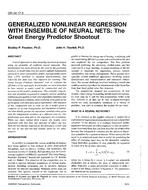Description
A novel approach to data modelling has been developed using an ensemble of artificial neural networks. This development has been driven by the need in the petroleum business to model data that has poorly defined independent parameters, poor repeatability and/or reproducibility (more than + or – 10% variation in repeated measurements), and relatively few data sets. The objective for entering “The Great Energy Predictor Shootout” was to evaluate the efficiency of this approach. How quickly a model could be constructed and the accuracy of the model’s predictions was of particular interest. This scientific competition was ostensibly to compare various modelling methodologies applied to both time-dependent (dynamic) and time-independent problems. Both problems were given to the participants with little descriptive information. The objective of this competition was to train (or fit) a model given a complete set of data (independent and dependent variables) and then blindly predict the dependent variables when given only the independent variables of a different data set. The predictions were then sent to the organisers for evaluation. While this entry ranked third overall, the models were generated with less than one man-day of effort – far less than the two months required by the first-place winner and the one to one-and-a-half months spent by the other winners.
KEYWORDS: artificial intelligence, expert systems, accuracy, calculating, competition, energy consumption, heat load
Citation: Symposium, ASHRAE Trans. 1994, Vol.100, Part 2
Product Details
- Published:
- 1994
- File Size:
- 1 file , 690 KB
- Product Code(s):
- D-17681




